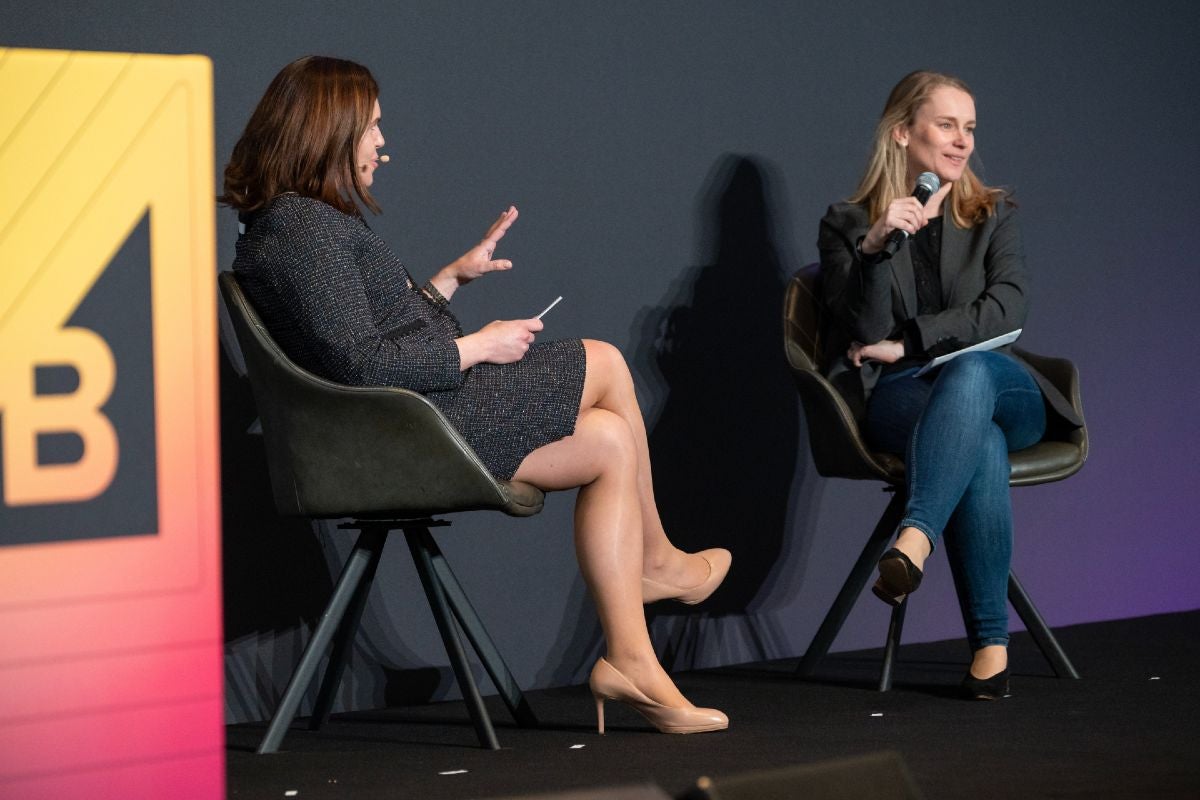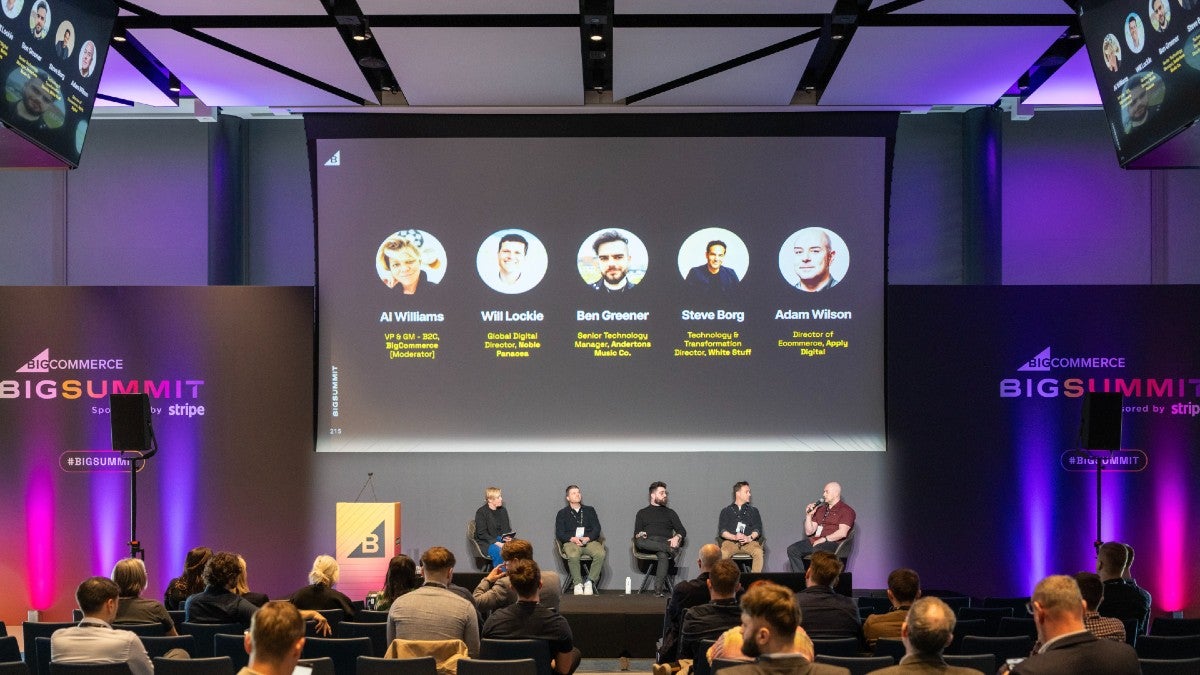What comes next: how innovation is reshaping ecommerce
Multi-channel ecommerce technologies, third party software integrations and AI are transforming the way digital businesses attract, engage and convert customers at scale.

Ecommerce is evolving at speed. Historically, businesses sold their products via traditional brick-and-mortar stores and then transitioned to a single, online, direct-to-consumer website. But in 2025, businesses are expected to sell their products or services across a plethora of channels and meet their consumers where they spend most of their time online.
Many ecommerce businesses now have a presence across four or more online channels. These could include a D2C store, online marketplace, social media platform, third-party reseller and mobile app. This creates a challenge in identifying lucrative new channels and then responding at speed to establish a frictionless and quality consumer experience.
It’s a challenge Travis Hess, CEO of BigCommerce, sees every day. “Organisational agility is essential,” he said at BigCommerce’s BigSummit conference.
“Businesses, independent of size, industry or vertical market, need to be able to go where their clients want to engage with them, to be able to experiment and do that with speed. But the majority are not set up to do this from an organisational, technology or talent perspective.”
Third party-powered innovation
BigCommerce has sought to solve this problem by partnering with and acquiring third party providers, and integrating them within its own platform.
In July 2021, it acquired product feed management and data optimisation platform Feedonomics, and then purchased no-code visual editor Makeswift in 2023.
These integrations are helping its clients to innovate rapidly and overcome a host of complex challenges as they expand across multiple channels.
One of the biggest challenges facing ecommerce businesses is how to transport quality data to and from their new channels.
Each one requires a data feed management platform to send data from a system of record, for example an ERP containing product catalogue information and consumer data around previous purchases.
This ensures the smooth processing of payments, facilitates orders and optimises advertising spend.
To do this, businesses used to have two options. First, build their own data feed platform in-house and integrate them within their current ecommerce platform.
Or move to a new solution that already had a feed installed. But both solutions created potential headaches for leaders, in terms of time, financial investment and software development expertise.
Data orchestration and AI-driven channel growth
BigCommerce’s acquisition and integration of Feedonomics has redefined what’s possible for merchants navigating the rapidly evolving landscape of agentic commerce.
At the core of this transformation is Feedonomics’ ability to harmonise and orchestrate product data across an ever-expanding set of digital channels—enabling merchants to unlock AI-powered growth at scale.
Sharon Gee, senior vice president and GM at BigCommerce, explains: “Feedonomics acts as the connective tissue between systems of record and revenue-generating endpoints.
We aggregate and normalise product data, enrich it with performance-optimised attributes, and dynamically syndicate it to the right channels—whether that’s Google, Meta, TikTok, Amazon, or emerging AI-discovery platforms.”
This orchestration enables merchants to maximise return on ad spend, improve product visibility, and future-proof their digital operations by supporting conversion both on owned websites and data-powered third-party channels.
Crucially, Feedonomics operates platform-agnostically—empowering brands with solutions that help merchants grow on their terms while evolving with the pace of technology. In an era where autonomous agents and AI-driven merchandising are reshaping how consumers discover and buy, Feedonomics equips merchants with the high-quality data needed to thrive.
Making composability more accessible
This approach is part of what the BigCommerce Inc team labels curated composability. It provides retailers and brands with customisable tools. But it also includes pre-composed architectures and pre-configured capabilities, so the technologies can quickly adapt and support the management of increasingly complex commerce operations.
This inspired BigCommerce’s to conceive Catalyst, a storefront framework that makes composable commerce more accessible with its pre-integrated front-end and integrate with the intuitive visual editor Makeswift.
An AI-driven future
The next wave of change in ecommerce is likely to involve artificial intelligence (AI). AI is already changing the way businesses attract, interact with and convert customers through chatbots and virtual assistants, create product descriptions, personalised product recommendations based on previous shopping experiences, dynamic pricing and demand forecasting and supply chain optimisation. But these are likely to be just the first steps of a transformative new era.
Speaking at BigCommerce Inc’s BigSummit, Piers Linney, founder of implement AI, described a future in which AI may tailor not just products, but entire shopping experiences.
This could include website layout, messaging, and even pricing to individual users. Businesses may even be able to deliver unique storefronts to individual consumers and have 24/7 conversations with them by using AI like a personal assistant, sort of AI agents that can hold nuanced voice-driven interactions.
Linney believes consumers will soon have their own AI agents to find suitable products and carry out transactions on their behalf. “Agents will be the connectors between the consumers and ecommerce platforms,” he said.
“Businesses will need to have finely tuned, automated algorithms to interact with agents and provide immediate product listings based on the consumer’s budget and previous buying habits.”
If that does become a reality, businesses that have already adopted an innovative approach to multichannel ecommerce will be the ones that thrive in an AI-driven future.
Turning innovation into conversions
Innovations in payment technology could help ecommerce businesses to reduce shopping basket abandonments and increase conversions.

Ecommerce businesses must overcome several hurdles before a shopper becomes a customer. Firstly, they must grab their attention on an online channel. Secondly, they need to tempt a consumer to add an item to their shopping basket. And finally, they must secure a conversion. But it is often that final piece of the jigsaw that proves most troublesome.
A study published by the Baymard Institute shows that the average shopping cart abandonment rate is 69.80%. This means that for every 10 shoppers, seven don’t follow through with completing their orders. There are several reasons for this, including: unexpected additional costs at checkout, mandatory account creation and limited payment options.
For the past decade, BigCommerce has partnered with leading payment solutions provider, Stripe, by integrating the software within its platform at no extra cost to businesses. The aim is to optimise the payment process and give retailers the flexibility to apply different payment solutions, for example subscription services or buy-now-pay-later, to their online stores.
Fanny Talagrand is Stripe’s head of EMEA for start-ups and SMBs. At BigCommerce Inc’s BigSummit, she discussed the importance of retailers optimising their payment processes to maximise conversions, how Stripe’s investment in innovation is yielding results for ecommerce businesses and the future of payments in 2025 and beyond.
Payments aren’t a cost centre, they’re a growth lever
Stripe has over nine million customers globally. Last year, those businesses processed 1.4 trillion payments – an increase of 38% year-on-year.
For many, the role of payments is changing. Previously, they were seen as a back-end function, but they’re fast becoming a strategic differentiator. Businesses see payments as an opportunity to offer a smoother, faster and more optimised experience. The result is optimised conversion rates and improved customer satisfaction.
Checkout experiences can make or break a purchase
If businesses don’t make payments a priority, they could lose customers. Data shows that 86% of customers will abandon their purchase if they don’t see their preferred payment option. Offering choices like Apple Pay, card, bank transfer, and Buy Now Pay Later options like Klarna or Affirm can make a big difference, especially with younger demographics.
Checkout speed is another opportunity to gain a competitive advantage. Stripe Link, for example, enables six-second checkouts by allowing customers to save their payment and shipping details. The average checkout is still around three minutes.
Customers expect personalised, frictionless experiences
Shoppers no longer accept fragmented experiences. Walking into a store or visiting a website should feel like interacting with one unified brand.
That means connecting data across touchpoints so businesses can better understand preferences and personalise experiences. Stripe helps unify those systems to provide a single customer view, which improves marketing efficiency and customer satisfaction.
A great example is Sarah Raven, a BigCommerce merchant, who had complex product setups and needed better performance and checkout experiences. Stripe helped streamline its mobile checkout and reinforce brand trust through reliable, fast payments.
Anti-fraud tech is essential
Fraud is one of the biggest challenges for any online seller, and it’s only getting more sophisticated. But Stripe Radar uses AI and the scale of its network to block fraudulent activity in real-time.
Stripe has reduced card testing by 80% across its platform. Radar benefits from global visibility. If it detects a bad actor in one region, it can block them elsewhere too. One Stripe customer, Cleo, used Radar to reduce chargebacks by $200,000 annually. Whether you’re B2C or B2B, strong fraud prevention is non-negotiable.
5 ways to engage the future ecommerce shopper
Businesses must create simple, engaging and streamlined user experiences and capture and action the right data, to nurture future shoppers from prospects to customers.

A good product or service will only engage tomorrow’s ecommerce shoppers if it’s accompanied by a quality user experience. But as businesses expand across multiple channels and develop more products, this becomes increasingly difficult.
At BigCommerce Inc’s BigSummit, retailers across a host of industries shared their biggest pain points and the solutions they’ve found to enhance their customers’ online shopping experiences. Here, we’ve used their insights to create a step-by-step guide.
Noble Panacea’s customers all share the same passion: high-tech skincare products. But the needs and concerns of each customer are individual. So helping customers know where to start, and where products sit in the customer’s skincare regime, was key.
To solve this problem, the brand made some simple changes. Firstly, increasing the amount of content around concerns, active ingredients and explaining how the technology works. Secondly, measuring the customer journey across the site to identify where customers were dropping off and looking to intervene where necessary.
“We’ve worked hard to help our customers know where to start, but there is always more to do,” says Will Lochie, Noble Pancea’s digital director.
“We need to simplify the user experience to help new customers make informed decisions, and then also, add the necessary services and features that speak to what existing customers value about the brand, such as expert skincare consultations, loyalty rewards, or subscriptions to refills.”
Businesses can’t engage shoppers online effectively if they don’t know how they’re engaging with their channels. Douglas De Santi is the Head of Direct to Consumer at Nextbase, a leading manufacturer of dashcams. He’s an expert in conversion rate optimisation, but for several years, he had a big problem in understanding customer behaviour.
We had too much data,” he says. “We had data from 15 different software providers and it was all hidden away in silos. This made it really difficult to understand where there were problems with the user experience.”
Six months ago, De Santi led a project to consolidate their customer data. “We wanted to work with our CDP vendor Klaviyo and found that it integrates seamlessly with BigCommerce. I implemented Klaviyo on BigCommerce in four or five regions within literally two hours. It was completely no code, and we can now clearly see coupon usage, return rates, social media campaigns all in one place.”
Customers expect ecommerce businesses to deliver content that is tailored to their needs on the right channels at the right time. This is a considerable challenge for Anderton’s Music Company, a retailer selling high-value electric guitars ranging from £150 to £20,000. To engage new and returning customers, the business segments them into groups and serves them different digital content.
“Beginners need both inspiration and education, so we deliver that through YouTube and other content designed to help newcomers get started,” says Ben Greener, the company’s senior technical manager.
“Aspirational shoppers are hobbyists who browse frequently, so the site is regularly updated with fresh content to keep them engaged. For those ready to make a purchase, the focus is on clear product discovery and informative content.”
In ecommerce, just a few seconds can be the difference between a sale and an abandoned shopping basket. Speed is therefore critical to give online shoppers fast-loading pages and rapid checkout experiences.
Steve Borg, technology and transformation director at White Stuff, tested the impact of speed on the conversion rate of the clothing brand’s new site.
During the dual running period between the old platform and BigCommerce, the site became 85% quicker overall and 100% faster on mobile phones, and saw an overall conversion rate improved 37% in the same period — which was also impacted by a switch from a three-page to a one-page check-out that has taken the friction out of purchasing.
“One of the major transformational parts of this project has been around content management,” he says. “We were spending days or even weeks developing a new campaign or executing changes.
With BigCommerce, we can now do this in hours or even minutes because we’ve got a content management solution and an ecommerce platform that seamlessly plug in together.”
One-page checkout is helping BigCommerce client Sarah Raven to simplify its payment process for its customers, even if orders are complex. The company’s customers are typically middle-aged or older and are offered a simple page, which communicates with its ERP software. Importantly, it also enables them to order easily via smartphone.
“Payment has been made a lot simpler by adding mobile wallets through Stripe,” says Ash Pallett, Sarah Raven’s senior digital and ecommerce manager. “In early 2024, we were up and running with Stripe, with a couple of clicks in the backend of BigCommerce, for card payments, Apple Pay and Google Pay wallets.”
Built to scale: tomorrow’s B2B ecommerce
B2B buyers expect businesses to provide the same online shopping experience they enjoy when shopping for consumer goods. To meet those expectations, B2B businesses are transforming their platforms and processes and making plans for an AI-first future.

B2B businesses must adapt to meet the needs of modern digital buyers. Over the past five years, those needs have changed considerably.
Pre-pandemic, many B2B businesses used paper-based orders, phone calls and dated internal systems to engage with their customers and sell their products. But in 2025, that’s no longer enough. Buyers now expect the same slick and seamless B2C experience when buying B2B products and services.
Personalisation is at the heart of these evolving wants and needs. BigCommerce’s Global B2B Buyer Behaviour Report revealed that customers now expect a service that goes beyond interactions with sales teams and prefer a buying experience that involves a mix of physical and digital interactions that results in a final purchase.
The report found that 74% of B2B customers use online platforms to transact or purchase, a further 64% adopt digital devices to research and browse and 56% request a quote online.
It’s a change Nicki Jamieson, head of sales operations at Srixon Sports Europe, a manufacturer of golf clubs and balls, has witnessed first-hand. “We sell to the entire golf industry – golf courses, club shops and big retailers – everyone has a different buying experience,” she says. “A lot of our end customers in pro shops have specific needs – for example, customising their clubs. We’ve had to build a platform to enable that.”
B2B vs B2C ecommerce
Lee Farmer has also noticed a shift in expectations borne out of the online B2C shopping experience. He’s the IT and operations director at Ellisons. The business has been a distributor of hair and beauty products to mobile therapists and salons for the past 95 years.
“Most of our customers are beauty therapists who who are trend and fashion-led. They are used to shopping on big brand sites,” he said at BigCommerce’s BigSummit. “They expect that same speedy ecommerce service in B2B.”
Those expectations aren’t just prevalent in the beauty industry. Mike Berry is the head of ecommerce at Graham & Brown, a manufacturer, distributor and wholesaler of home decor products. “Things have moved quickly,” he said.
“Our customers want to be serviced at their time,” he said. “They want a fast experience. They want to see all of our product and lives tock availability. They want their pricing and credit availability all in one place.”
For manufacturers, distributors and wholesalers, the need to change is clear. They must also do so at speed to avoid the risk of falling behind competitors who can offer a superior ecommerce experience. But many B2B businesses have run into problems after realising their existing platforms and tools lack the speed and flexibility to innovate.
“The performance of our platform was too slow,” says Farmer. “A lot of our issues were with invoicing and quoting online. It was incredibly slow because we were using dated, siloed systems. We needed a system that gave us more flexibility.”
For Berry, there were frustrations with the inability to automate routine tasks. “We were spending way too much time doing low-value-added tasks like order entry and responding to basic service requests.”
BigCommerce-powered B2B
All three businesses have turned to BigCommerce to transform their ecommerce operations. Lance Owide, VP and GM of B2B at BigCommerce, says its tools support the need for speed and scalability in today’s digital marketplace.
“We support B2B processes straight out-of-the-box,” he says. “We have ready-made workflows for quotes, invoices and buyer approvals, as well as SKU grids, CSV uploads, quick reorder functions, requisition lists, and advanced sales team tools. They’re all designed to meet the complex demands of B2B commerce.”
At the heart of BigCommerce’s offering is a suite of powerful, scalable APIs that can manage the intricacies of B2B operations. These APIs are built to handle the sheer volume and complexity typical in B2B environments, including hundreds of thousands of price lists, millions of SKUs, and complex product configurations. This level of scalability ensures that as businesses grow and evolve, their digital infrastructure remains agile and responsive.
But with so many options available, businesses must prioritise the tools that will have a real-world impact on their clients and deliver a competitive advantage. During Graham & Brown’s ecommerce transformation, Berry enlisted the help of some of the firm’s biggest accounts to guide their development.
“We worked with them right from concept, through to testing and launching,” he explains. “We wanted to create an ecommerce experience that was perfectly aligned with the expectations of our customers.”
That process revealed the desire for a specific tool to enhance their buying experience. “We realised that they wanted a feature to be able to request a specific batch of the product, which is something that is unique to wallpaper,” he says.
“We were then able to then develop that and get it ready for the launch. Working closely with customers through the process was really valuable for us – it helped us to avoid a whole lot of pain.”
Transforming processes and platforms
The shift to a modern and sophisticated ecommerce platform also creates an opportunity to redesign faulty processes and spark positive internal change. “A lot of people will try to fit an internal process into a new solution,” says Farmer.
“But the first thing I say when we undergo a change in ERP or website is to rip up all the processes or at the very least assess them. New technologies give you an opportunity to reset and do things better.”
When new processes and technology are aligned with the needs of customers, B2B businesses can create the perfect environment for new buyer behaviours to flourish. Within a month of launching their new platform in January 2025, a third of Graham & Brown’s smaller customer orders were already coming through their self-service portal. This freed up internal teams to focus on more strategic work.
For Ellisons, the BigCommerce-powered site delighted Lee. “Our customers love our delivery and service, but prior to moving to BigCommerce, the Trustpilot feedback was that they would make their tea, and then sit down and place an order with us, knowing it would take time.” says Farmer. “We’ve now managed to reduce the wait time on our shopping basket from six seconds to two seconds – that’s a huge improvement in performance.”
AI-powered pricing and negotiation
In the near future, advances in B2C commerce could help to predict the future of B2B. AI is already helping to automate areas such as product recommendations and customer service.
In B2B, the tech could soon transform the complexities of pricing. Unlike B2C, pricing is rarely one-size-fits-all, with negotiation, discounts and complex structures commonplace.
“We’re looking at AI negotiation and pricing now,” says Farmer. “We sell some high ticket items, and customers will request discounts over the phone or by email. We can negotiate a price directly and instantly with a customer using AI.”-
As the needs of modern buyers continue to evolve, leaders who embrace innovation now will be best positioned to win in an increasingly tech-driven B2B commerce marketplace.

